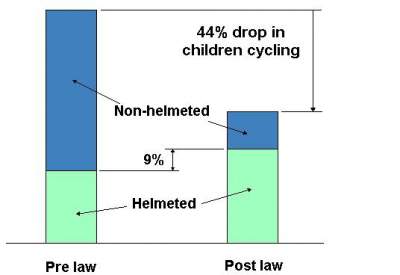Abstract
After the helmet law, the risk of accidents doubled.
The risk of death & serious injury for child cyclists increased by 50%.
Wearing a helmet can make us feel safer. However feeling safe is different than being safe
blank
A noticeable impact of the helmet law has been to reduce cycling. Almost half stopped cycling, while only 9% put on a helmet.
Some government funded studies claim the helmet law has reduced injuries. Such “studies” ignore that:
- There were 30 to 40% fewer cyclists. The risk must be adjusted per cyclist.
- The helmet law was introduced at the same time as other road safety measures. To isolate the impact of the helmet law, cycling safety must be compared with pedestrian safety.
Those studies attribute all apparent improvements to helmets, without considering confounding factors. After adjusting for those factors, the decline in head injuries vanishes.
Dr. Dorothy Robinson has done thorough research in this area. She concludes the helmet law has increased the risk of injury:
“mandatory bicycle helmet laws increase rather than decrease the likelihood of injuries to cyclists …
Having more cyclists on the road is far more important than having a helmet law, for many reasons …
[the] governments [which introduced the helmet laws] do not like to admit they’ve made mistakes”.
A summary of Dr. Robinson’s work concludes:
More importantly, risks per cyclist seem to have increased, compared to what would have been expected without the law, implying that helmet laws are counter-productive. Possible explanations include risk compensation, reduced ‘Safety in Numbers’ and that brain damage is predominantly due to rotational injury.
A more detailed analysis reveals that, after the helmet law:
- the risk of death and serious injuries increased by 21% for child cyclists .
- the risk of death and serious injuries decreased by 21% for child pedestrians.
Cycling injuries decreased less than the reduction in number of cyclists.
The risk of death & serious injury for child cyclists increased by 50%.
This may be due to risk compensation.
A false sense of safety can induce people to take more risks, leading to more accidents and more injuries. This tendency is called risk compensation, a well-known safety factor as reported here:
“the law of unintended consequences is extraordinarily applicable when talking about safety innovations. Sometimes things intended to make us safer may not make any improvement at all to our overall safety”
Wearing a helmet can induce cyclists to take more risks, as reported in the New York Times:
“the rate of head injuries per active cyclist has increased 51 percent just as bicycle helmets have become widespread. …
the increased use of bike helmets may have had an unintended consequence: riders may feel an inflated sense of security and take more risks. …
The helmet he was wearing did not protect his neck; he was paralyzed from the neck down. …
”I definitely felt safe. I wouldn’t do something like that without a helmet.” ”
Safety experts recognise the role of risk compensation. From the New York Times article:
”People tend to engage in risky behavior when they are protected,” he said. ”It’s a ubiquitous human trait.”
Even cyclists who discount the daredevil effect admit that they may ride faster on more dangerous streets when they are wearing their helmets.
A 1989 study found that helmet wearers were 7 times more likely to have accidents.
Risk compensation also affects motorists who tend to be less careful around helmeted cyclists. As reported in a study published by the University of Bath in the UK:
“Bicyclists who wear protective helmets are more likely to be struck by passing vehicles”
Both the behaviour of the helmeted cyclist and surrounding motorists increases the risk of accidents.
There is a well-known phenomenon called safety in numbers. Research published in the Injury Prevention journal concluded:
“the behavior of motorists controls the likelihood of collisions with people walking and bicycling. It appears that motorists adjust their behavior in the presence of people walking and bicycling …
A motorist is less likely to collide with a person walking and bicycling if more people walk or bicycle. Policies that increase the numbers of people walking and bicycling appear to be an effective route to improving the safety of people walking and bicycling.”
According to “safety in numbers”, a 44% decline in cycling increases the risk of accidents by 41%. A 9% increase in helmet wearing cannot compensate for a 41% increase in accidents. The helmet law has increased the risk of injury by increasing the risk of accident.
Evidence of an increase in accidents can be seen in Table 2 on Page 465 of the report. The risk of non-head injuries doubled, indicating that the risk of accidents doubled.
The risk of accident almost doubled. The risk of death & serious injury increased by 57%.
This is similar to what was observed for children and adults, where the risk of injury tripled.
Cycling has become more dangerous after the helmet law.
In Australia, the cyclist fatality rate is now five times greater than in the Netherlands. The serious injury rate is 22 TIMES greater. The fatality rate per commuter cyclist is 27 times higher in Sydney, Australia than in Copenhagen, Denmark.
New Zealand introduced a bicycle helmet law in 1994. In a cycling safety perception survey, 83% report that cycling has become more dangerous.
In 1988, the largest ever cycling casualty study was published. It involved more than eight million cases of injury and death to cyclists over 15 years. It concluded
“There is no evidence that hard shell helmets have reduced the head injury and fatality rates. The most surprising finding is that the bicycle-related fatality rate is positively and significantly correlated with increased helmet use.”
Rodgers, G.B., Reducing bicycle accidents: a reevaluation of the impacts of the CPSC bicycle standard and helmet use, Journal of Products Liability, 11, pp. 307-317, 1988.







